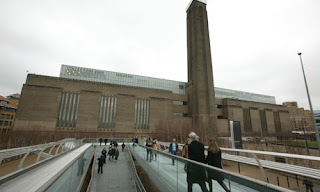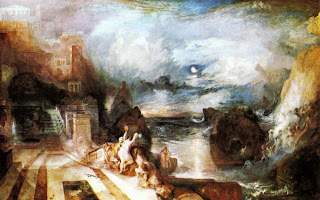I don't think this qualifies as a logo, however the typeface is very interesting, with heightened serifs. I think the L's stand out with the angled serifs, and the R in Gallery has the extended serif, which gives it a very classy and posh feel. The museum is the most traditional of the museums we've visited, its a traditional art gallery, so I feel like not only the typeface, but the actual words are the logo to the museum. It is where to find classical art. The whole package symbolizes the museum more accurately than a logo or one picture can. I love the typeface and prefer this to anything else.
I appreciated the wall panel design at the National Gallery. I haven't developed a solid opinion on whether I prefer blank walls or patterned or colored, but this enhanced my experience. I dont think my appreciation of the specific painting were increased, but when I walked into a new gallery, I think the ambiance of the room was incredible. I loved one room with blue wallpaper and few paintings over each other, so the whole wall was covered. The room itself looked like art.
When I visited the National Gallery in 2006, I bought a poster-painting of Monet's foggy London painting, and it has hung in my room ever since. I love looking at it, mostly because it reminds me of London and that trip and the museum. Obviously it doesn't capture the beauty of the actual piece, but it's still a fantastic piece of nostalgia. I'm honestly surprising myself by saying this, because at first thought, I hated that they'd try and recreate or sell knockoffs of the beautiful paintings. But thinking about my poster-painting from home, I really have to contradict myself. It is a fantastic souvenir that reminds someone of the beautiful painting and of the great trip to London. It's worth "profiteering" like that, solely because it brings me, and I assume others, happiness.
On the left is my piece of desire and on the right is my piece of appreciation. I love how later in his life, Monet essentially recreated the famous Japanese bridge in a more abstract sense, really using color to emphasize the water. If anything, the bridge is apart of nature, and looking at Monet's other water Lilly paintings, he certainly believes that whole area to be serene and all beautiful, so it makes sense that the bridge is part of its surroundings. The color emphasized here is turquoise, which is a nice blend of green and blue, or of land and water. This painting reminds me of Avatar, to be honest. The illuminating plant life and nature on Pandora is exotic and almost hallucinogenic. This painting reminds me of that. I also love how Monet hardly ever uses blue to paint water. It's full of pink and green and yellow, completely distorting the scene around the water. It's stunning.
The more traditional but still very surreal Japanese Bridge painting is the one that belongs in my house. There will be a room with all white walls (or that blue wallpaper) and a chair for me to sit in and look at the painting. Always with Monet, I am fascinated with his water. I look up close to see what odd colors he included in the water, and then stand back to see it as one whole unit. The scene itself is a place I'd love to read a book or think, sitting on the grass looking at the bridge and the bank. I really hope to visit this area in France and just take it all in, like I'm in a Monet painting.
















